The ancient Maya civilization once spanned southern Mexico, Guatemala, and Belize. They left behind a breathtaking legacy of cities, temples, and ceremonial centers. Cahal Pech Mayan ruins offer a quiet, intimate connection to this fascinating history. Located just above San Ignacio, this compact archaeological site is one of the oldest Maya settlements in Belize. This makes it a must-see for history lovers and curious travellers alike.
The legacy of the Maya in Belize
Belize is one of the most important regions in the ancient Maya world. Thousands of years ago, this area was dotted with ceremonial centers, pyramids, and vibrant cities built by the Maya civilization.
Pre-Classic Period
Cahal Pech was first occupied around 1200 B.C. The first settlers established their small village at the summit of what was one of the highest hills overlooking the upper Belize River Valley.
During the Middle Pre-Classic Period (900-300 B.C.) the early Cahal Pech Village underwent enormous changes. The communication between communities increased.
By Late Pre-Classic times (300 B.C. – 300 A.D.) Cahal Pech had grown substantially, flourished and became one of the primary centers in the upper Belize River Valley. By the end of Late Pre-Classic times the small villages had become thriving towns and precious cities.
This time the Maya civilisation with its hieroglyphic form of writing, solar calendar, vigesimal system of mathematics, complex art and monumental architecture became fully established.
Classic Period
During the Classic Period (300-900 A.D.) most Maya communities continued to grow and prosper. But competition between dominant polities often led to conflicts, which are recorded on carved monuments. In this Late Classic Period, a lot of people lived at Cahal Pech, it is estimated between 10.000-20.000 people. A number of similar sized cities e.g. Xunantunich also prospered in the upper Belize Valley, and competed with Cahal Pech.
Despite these achievements, however, the Maya system in the lowlands eventually failed. And people began to abandon many of the once thriving cities. What caused this decline is still debated by archeologists. But many believe it may have been a combination of social and environmental stresses and the inability of the political and economical system to adequately deal with the changes.
During the Postclassic Period (900-1500 A.D.) Maya society underwent significant changes. Maya rulers no longer enjoyed the godly stature and power they once had. With the abandonment of many inland cities, the foundation of new communities had risen along coastal regions and major waterways. The importance of maritime trade also increased, leading to the rise of more powerful and influential merchant class.
Colonial Period
In the Colonial Period (1500-1800 A.D.), when the Spaniards arrived in the 15th century Maya culture was still in the process of adjusting to new social, economical and political systems. Thanks to this, the Spanish soon dominated much of the Maya area. On several occasions the Maya revolted against it. Despite the battles, the Maya of Belize were still free from Spanish domination when the British arrived in the late 17th century.
Interesting facts
The Maya used gold, but not until the Late Postclassic Period. However, their precious stone was jade. And Cacao was used as currency, also in most Mesoamerican cultures, such as Aztecs, Mixtecs and Maya.
The Maya recorded lunar and solar cycles, eclipses and movements of planets with great accuracy. Their solar year had greater accuracy than the Julian year. The Maya calendar was the center of religious practices. They also made meticulous observations of celestial bodies.
The most important Maya rituals were the sacrifice of a human life, which was the ultimate offering of blood to the gods. The ancient Mayas commonly used cenotes for water supplies, and occasionally for sacrificial offerings. The cenotes were sacred wells for them and entrances to the underworld.
The steps of their temples are so high, because of religious reasons. The temples were not made for anyone and everyone to climb. These places were sacred. They were only used for important rituals, and were only accessed by elite rulers, priests and their assistants. These people had to climb the temples with much dignity and obeisance. Possibly on hands and feet as a sign of respect to the deities they were about to worship. You can try to climb a few of the pyramids in Cahal Pech.
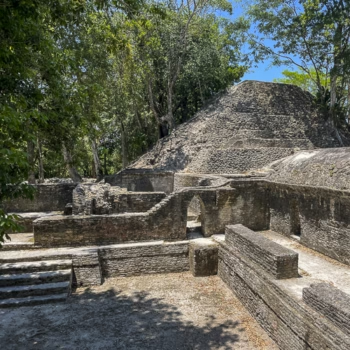
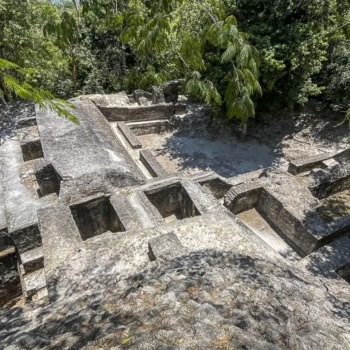
Welcome to San Ignacio
San Ignacio is located in the western part of Belize, in Cayo District, and was originally named El Cayo by the Spanish. The town serves as a cultural-economic hub. Today it is merged with the town of Santa Elena and became the largest settlement in Cayo District. San Ignacio is situated on the banks of the Macal River, about 101 km (63 miles) west of Belize City, and 35 km (22 miles) west of the country’s capital, Belmopan.
San Ignacio is the perfect base for exploring the western part of the country. It is known for its friendly atmosphere, colourful market, and easy access to nature and ruins. The town is a favourite among backpackers and travellers. From here, you can visit waterfalls, caves, and Maya temples or simply enjoy a relaxing stroll through the lively streets.
If you stay in San Ignacio also visit the Hawkesworth Bridge, which connects the town with Santa Elena. This bridge is the only suspension bridge in Belize and has only one lane. There is another bridge in the town, a wooden bridge, it is also worth a visit. And just a short uphill walk from the city center lies one of the town’s greatest hidden gems: Cahal Pech Mayan ruins.

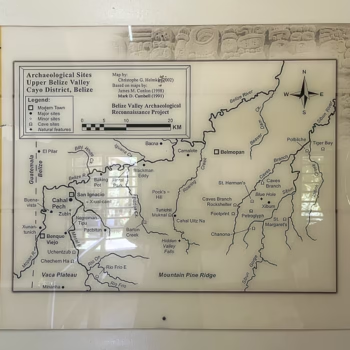
Visiting Cahal Pech
Today, Belize is home to numerous archaeological sites. Including Caracol, Xunantunich, and smaller, yet historically significant places like Cahal Pech Mayan ruins. While some are hidden deep in the jungle, others, like Cahal Pech are surprisingly accessible, sitting just minutes away from modern towns.
The name Cahal Pech is a combination of words from the Yucatec and Mopan Mayan language and means “Place of the Ticks”. Despite the name, there are no ticks in Cahal Pech.
This small but fascinating site is one of the oldest known Maya settlements in Belize, with history dating back to around 1200 B.C. The ruins are compact but rich in atmosphere. You will find several courtyards, palaces, temples and ceremonial buildings surrounded by dense greenery. It’s rarely crowded, so you can explore at your own pace, and even climb a few of the structures for a better view.

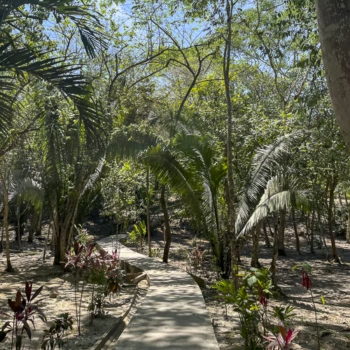
The site is situated on the ridge of a high hill overlooking the Macal River, which allowed them to control not only the trade on the river, but the rich, fertile valley to the north.
At the beginning, after entering, there is a small museum where you can learn about the town and Maya history. Wear comfortable shoes, because of the uneven terrain outside and bring water and sunscreen.
Entrance fee is USD $5.00 or BZD $10.00. The site is open from 8 A.M. to 5 P.M.
Where to stay: Yellow Belly Backpackers Hostel
If you’re looking for affordable and social accommodation in San Ignacio, Yellow Belly Backpackers Hostel is a great choice. It was founded in 2020, during the Covid-19 pandemic. Since they welcomed their first guest at the beginning of 2021, the hostel became a popular spot for travellers seeking adventure.
It’s clean, relaxed, and full of character. The hostel offers shared 8-bed, 6-bed, or 4-bed dorms and private rooms for one or two persons. The rooms are quite spacious and equipped with lockers. The bathrooms are shared, but private. There are a lot of social activities in the hostel, a shared kitchen, and a rooftop terrace for hanging out and maybe drink some Belikin beer. They have helpful staff who can help organize tours and give local tips. Even they have their own Tour Operator, Yellow Belly Tours, and they offer affordable tours to popular sights around San Ignacio.
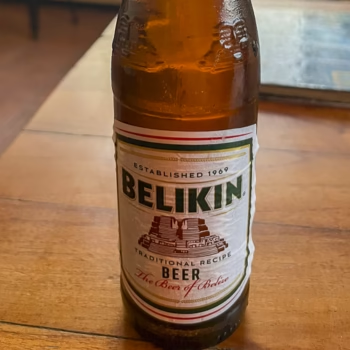
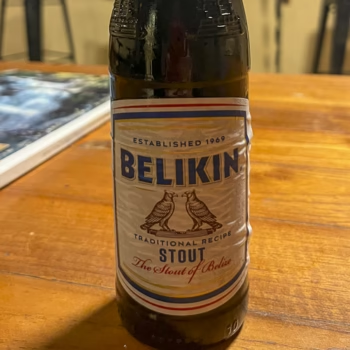
It’s located close enough to town to walk to restaurants, the bus station, and the market. But just far enough to offer peace and quiet after a day of exploring. Plus, it’s perfectly positioned if you are heading up to Cahal Pech. The ruins are reachable within 5 minutes on foot from the hostel, you just have to go up the hill.
Address: they are located by the Cahal Pech roundabout, 1 Caracol Street, San Ignacio, Belize
Prices: Dorms from ~$15–20 USD per night, private rooms ~$40–45 USD per night
Amenities: Wi-Fi, lockers, kitchen, rooftop, laundry service, free breakfast (included in the price), free bikes
Atmosphere: Friendly, laid-back, and great for meeting other travellers
Here you check their FB and IG pages.
Where to eat: Ko-Ox Han-Nah restaurant
Ko-Ox Han-Nah is a cosy little restaurant & meat shop in downtown San Ignacio. They specialising in burgers, quesadillas and curry. The menu is a mix of Caribbean, Belizean, Central American and Indian food. The name of the restaurant means “Let’s go eat” in Mayan language.
I tried the shrimp curry, it was a very flavourful dish, which costed 38 BZD (~19 USD). So, it is not on the cheap side, but the food is tasty.
Address: 5 Burns Avenue, San Ignacio, Belize
Here you can check the FB and IG page of the restaurant.
Other sites near San Ignacio
While Cahal Pech Mayan ruins is an ideal introduction to Belize’s ancient Maya heritage, there are other incredible archaeological experiences in the area. If you’re planning a longer stay, consider visiting Xunantunich. It is known for its towering El Castillo pyramid and views over the Mopan River. Or the ATM Cave (Actun Tunichil Muknal), an adventurous journey into an underground world of crystallised skeletons and Maya artifacts. I haven’t explored these just yet, but they’re high on my list and highly recommended by fellow travellers.
Cahal Pech Mayan ruins may not be the largest Maya site in Belize, but it offers something truly special: tranquility, accessibility, and a powerful sense of ancient presence. Its peaceful hilltop setting and well-preserved plazas, temples, and passageways make it easy to imagine what life was like here over 2,000 years ago. If you’re exploring San Ignacio or the Cayo District, don’t miss the chance to step into this lesser-known chapter of Maya heritage. It’s history, serenity, and culture all in one place.



